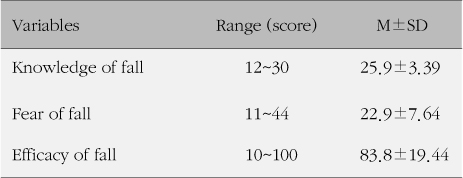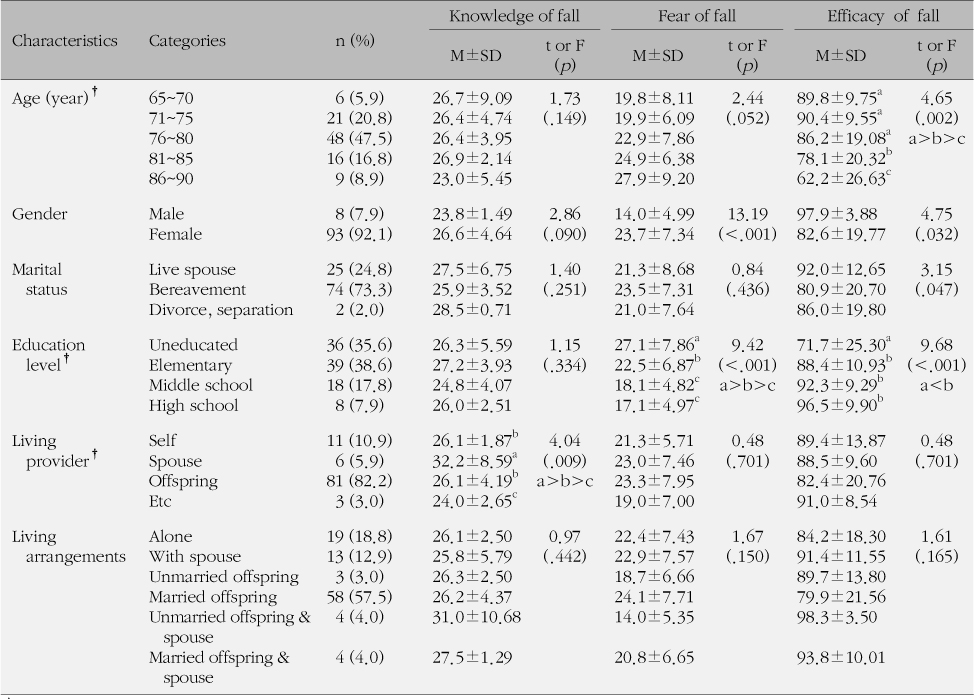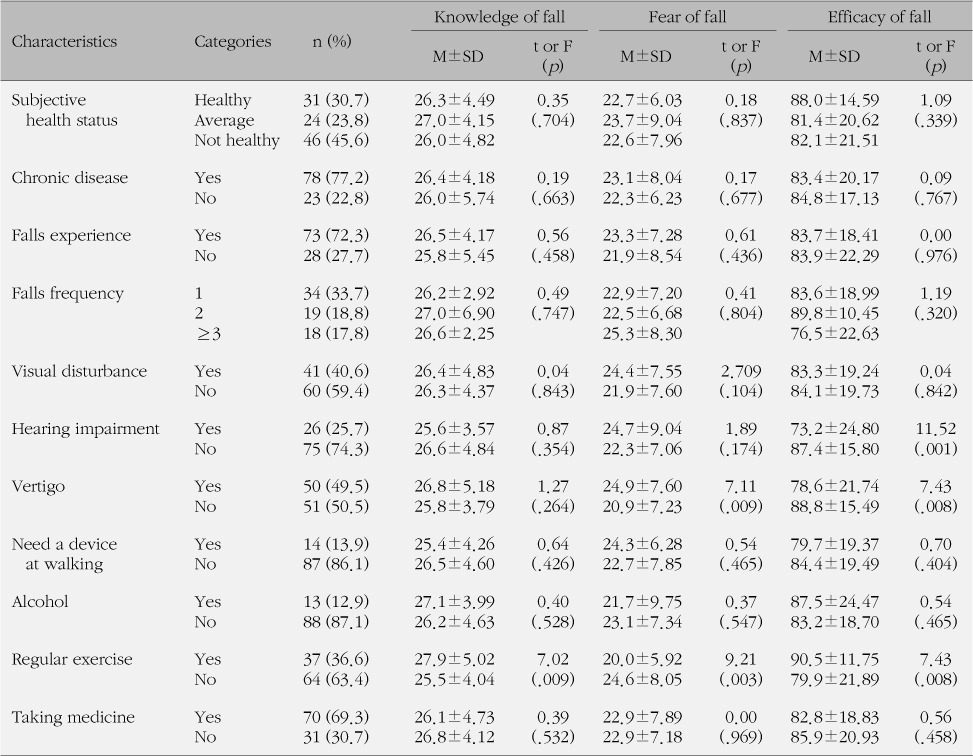References
1. Chang CM. A structural model for falls and quality of life in elderly people living at home Seoul: Kyung Hee University; 2005. Unpublished doctoral dissertation.
2. Chang CM, Kang HS. Physical function and psychological status in the elderly those who experienced a fall or not. Korean J Rehabil Nurs 2004;7(1):48–57.
3. Choi JH. The effects of Tai Chi exercise on physiologic, psychological functions, and fall in fall prone elderly Seoul: Catholic University of Korea; 2002. Unpublished doctoral dissertation.
4. Cumming RG, Salkeld G, Thomas M. Prospective study of the impact of fear of falling on activities of daily living, SF-36 scores, and nursing home admission. J Gerontol A Biol Sci Med Sci 2000;55(5):M299–M305.
5. Deshpande N, Metter EJ, Bandinelli S, Lauretani F, Bandinelli S, Windham BG, et al. Activity restriction induced by fear of falling and objective and subjective measures of physical function: A prospective cohort study. J Am Geriatr Soc 2008;56(4):615–620.
6. Friedman SM, Munoz B, West SK, Rubin GS, Fried LP. Falls and fear of falling: Which comes first? A longitudinal prediction model suggests strategies for primary and secondary prevention. J Am Geriatr Soc 2002;50(8):1329–1335.
7. Hakim RM, Roginski A, Walker J. Comparison of fall education methods for primary prevention with community-dwelling older adults in a senior center setting. J Geriatr Phys Ther 2007;30(2):60–68.
8. Hur JY. Knowledge and attitude toward falls among elderly inpatients Seoul: Yonsei University; 2007. Unpublished master's thesis.
9. Hyeon IS. The effects of a fall prevention program on the knowledge, efficacy, and preventive actions of falls among the low-income elderly Daegu: Keimyung University; 2008. Unpublished master's thesis.
10. Jung D. A prediction model of fear of falling in older adults living in a continuing-care retirement community (CCRC) in United States. J Korean Gerontol Soc 2009;29(1):243–258.
11. Kim SJ. Risk factors of falling in the elderly in urban cities Seoul: Ewha Womans University; 2004. Unpublished master's thesis.
12. Kim SW, Yang YJ, Eo KS, Cho HJ, Kim YS. Fear of falling in elderly persons living in a home for the aged. J Korean Acad Fam Med 1998;19(2):1400–1409.
13. Kressig RW, Worf SL, Sattin RW, O'Grady MA, Greenspan A, Curns A, et al. Associations of demographic, functional, and behavioral characteristics with activity-related fear of falling among older adults transitioning to frailty. J Am Geriatr Soc 2001;49(11):1456–1462.
14. Lee HY, Bak WS, Yang HI. Fear of falling and falls efficacy with bone mineral density in the middle and old aged women. J Muscle Joint Health 2009;16(1):5–12.
15. Lee MS. Manan community health survey analysis Anyang: Manan-gu elderly health center; 2007.
16. Li F, Fisher KJ, Harmer P, McAuley . Falls self-efficacy as a mediator of fear of falling in an exercise intervention for older adults. J Gerontol B Psychol Sci Soc Sci 2005;60(1):P34–P40.
17. Nikolaus T, Bach M. Preventing falls in community-dwelling frail older people using a home intervention team (HIT): Results from the randomized falls-HIT trial. J Am Geriatr Soc 2003;51(3):300–305.
18. Liu MR. The effects of Tai Chi exercise program on physical strength, fall related perception and health status in nursing home elderly Daejeon: Chungnam National University; 2007. Unpublished master's thesis.
19. Rubenstein LZ, Josephson KR, Robbins AS. Falls in the nursing home. Ann Intern Med 1994;121(6):442–451.
20. Salminen MJ, Vahlberg TJ, Salonoja MT, Aarnio PT, Kivela SL. Effect of a risk-based multifactorial fall prevention program on the incidence of falls. J Am Geriatr Soc 2009;57(4):612–619.
21. Scheffer AC, Schuurmans MJ, Dijk N, Hooft T. Fear of falling: Measurement strategy, prevalence, risk factors and consequences among older persons. Age Ageing 2008;37(1):19–24.
22. Seo HL, Kim SK, Yeom WS, Lee EC, Baek YH. The study on self-care status, activity of daily living and physical self-efficacy of aged people. J Res Inst Phys Educ 1998;14:133–143.
23. Shaw FE. Prevention of falls in older people withdementia. J Neural Transm 2007;114(10):1259–1264.
24. Shumway-Cook A, Silver IF, LeMier M, York S, Cummings P, Koepsell TD. Effectiveness of a community-based multifactorial intervention on falls and fall risk factors in community-living older adults: A randomized controlled trial. J Gerontol A Biol Sci Med Sci 2007;62(12):1420–1427.
25. Sohng KY, Moon JS, Kang SS, Choi JH. The survey of activities and fear of falling in the community dwelling elderly. J Korea Community Health Nurs Acad Soc 2001;15(2):324–333.
26. Statistics Korea. Elderly statistics in 2008 2008. Retrieved February 10, 2010. from
http://www.nso.go.kr.
27. Tideiksaar R. Falling in old age. Prevention and Management 2nd edth ed. New York: Spring Publishing Company; 1997.
28. Tinetti ME, Richman D, Powell L. Fall efficacy as a measure of fear of falling. J Gerontol 1990;45:P239–P243.
29. Tinetti ME, Baker DI, Dutcher J, Vincent JE, Rozett RT. Reducing the risks falls among older adult in the community. Berkeley, CA: Peaceable Kingdom Press; 1997.
30. Vassallo M, Vignaraja R, Sharma JC, Briggs R, Allen S. The relationship of falls to injury among hospital inpatients. Int J Clin Pract 2005;59:17–20.



